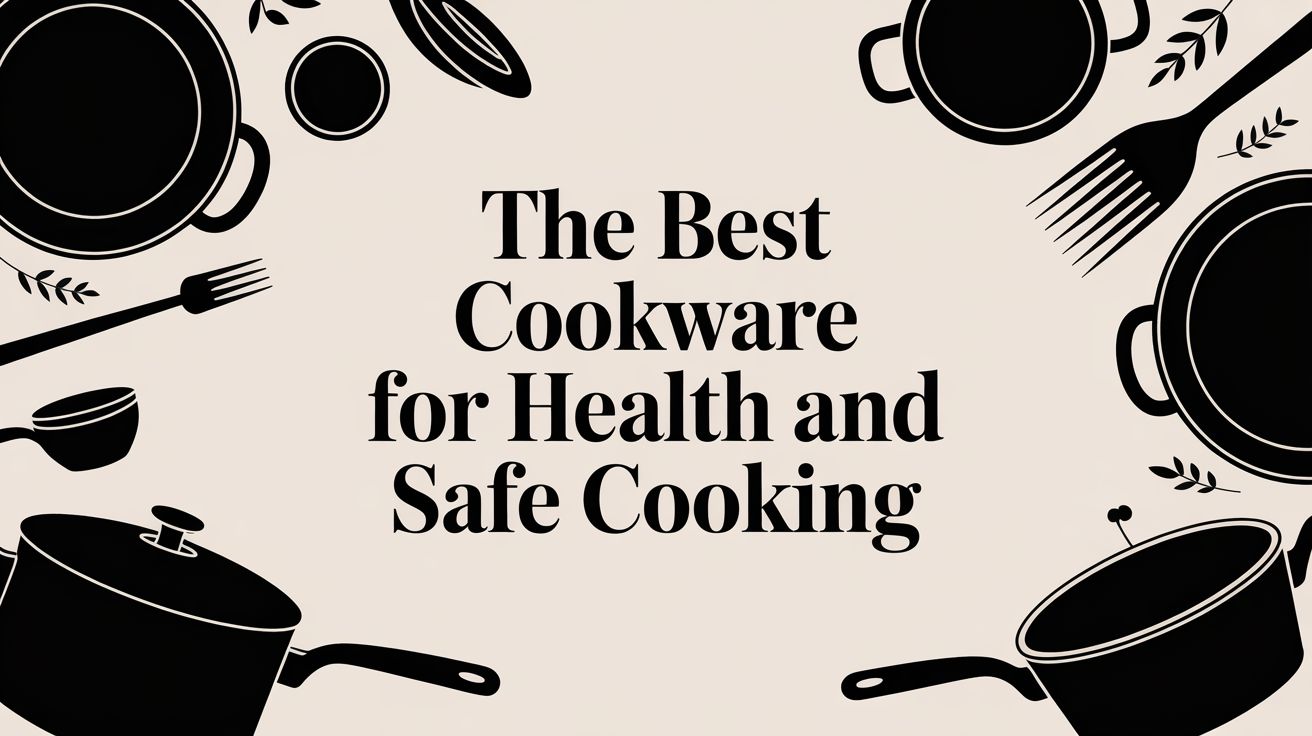When it comes to healthy cooking, the best cookware is always made from inert, non-reactive materials. Think pure titanium, high-quality stainless steel, and well-seasoned cast iron. These materials get top marks because they don’t leach unwanted chemicals or metals into your food, keeping your meals pure and your family safe.
Why Your Cookware Choice Matters for Health
The pots and pans you use every day are more than just tools; they're a vital part of your family's health. We’re seeing a real shift in home kitchens, with more and more people consciously choosing safe, non-toxic materials over the convenience of a cheap non-stick pan. It’s a move away from questionable coatings and towards durable, trustworthy options that don’t interfere with your food.
This isn’t just about avoiding toxins. It's about a deeper appreciation for quality cooking and long-term well-being, where the tools we use are just as important as the ingredients we buy.
The Connection Between Materials and Health
It all comes down to a simple principle: your pan’s material can interact with your food, especially when you turn up the heat or cook with acidic ingredients like tomatoes or lemon juice. Some materials are simply not stable enough and can break down over time, releasing compounds that end up in your meal.
This infographic breaks down the link between different cookware materials, the risk of chemical leaching, and what that means for your health.
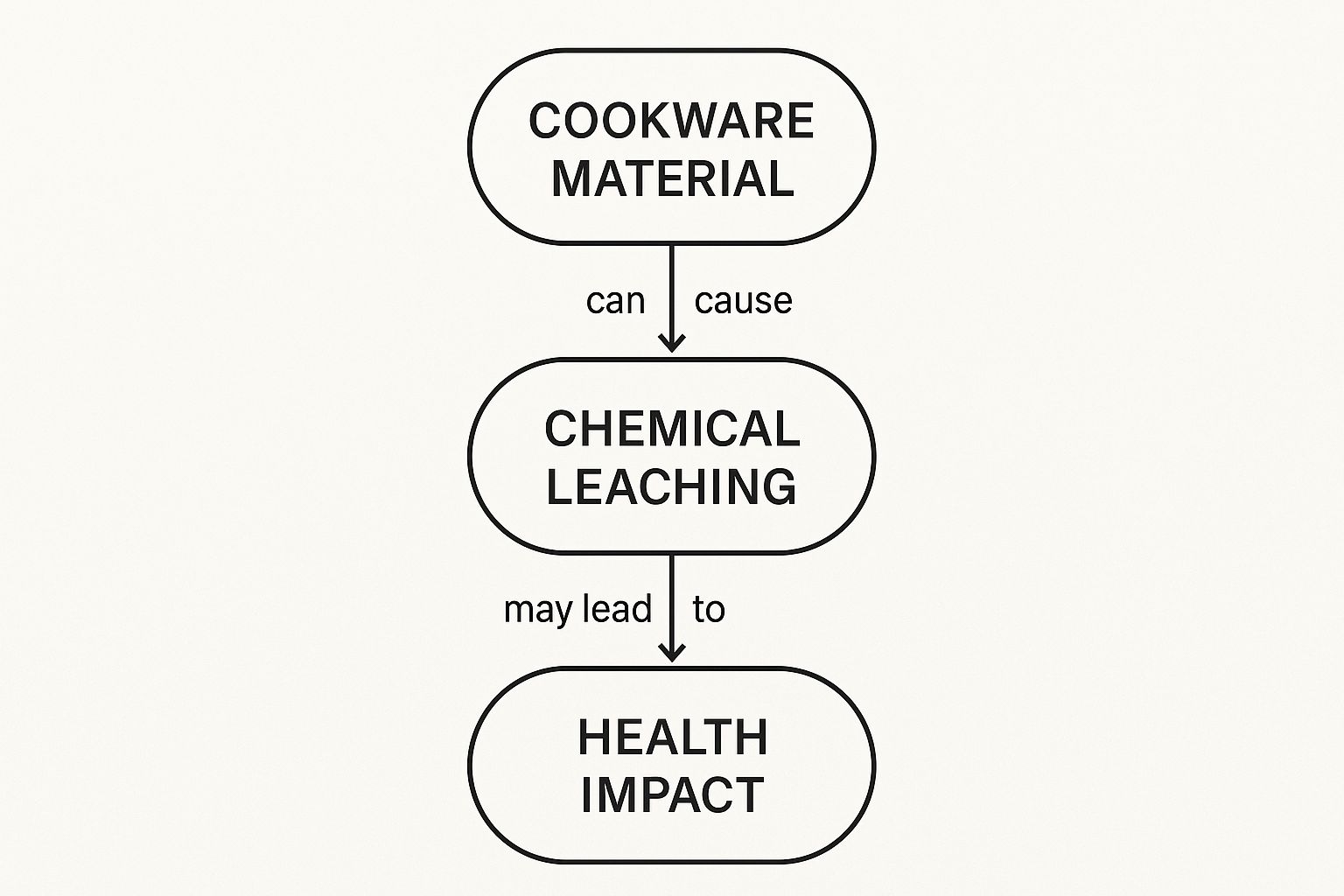
As you can see, the path to a healthier kitchen really starts with choosing cookware that is chemically stable and non-reactive.
This focus on health isn't just a fleeting trend—it’s changing the market. Here in Australia, the demand for safer cooking gear is booming. Valued at USD 664.44 million in 2024, the Australian cookware market is forecast to more than double by 2033. This incredible growth reflects a deep-seated desire for healthier home cooking, which you can read more about in these Australian cookware market trends on imarcgroup.com.
Choosing the right cookware is an act of preventative health care. By selecting materials that are proven to be safe and stable, you eliminate a significant source of potential chemical exposure in your daily life, creating a safer environment for your family.
At the end of the day, knowing what’s in your pans is just as critical as knowing what’s in your pantry. Making an informed choice is an investment in your family's long-term health and gives you complete control over your kitchen environment.
Understanding Different Cookware Materials
Choosing the right cookware can feel a bit like navigating a maze. You’ve got stainless steel, cast iron, non-stick, ceramic, and titanium, and each one seems to have its own playbook for cooking and care. It helps to think of your pots and pans like the soil in a garden—what you grow your food in has a direct impact on its quality and purity. What your cookware is made from matters just as much as the fresh ingredients you pick up at the market.
Not all materials are created equal, though. Some are incredibly stable and safe, while others can break down over time, potentially leaching unwanted stuff into your meals. Let's walk through the most common materials, breaking down the good, the bad, and the science behind them so you can make a truly informed choice for a healthier kitchen.
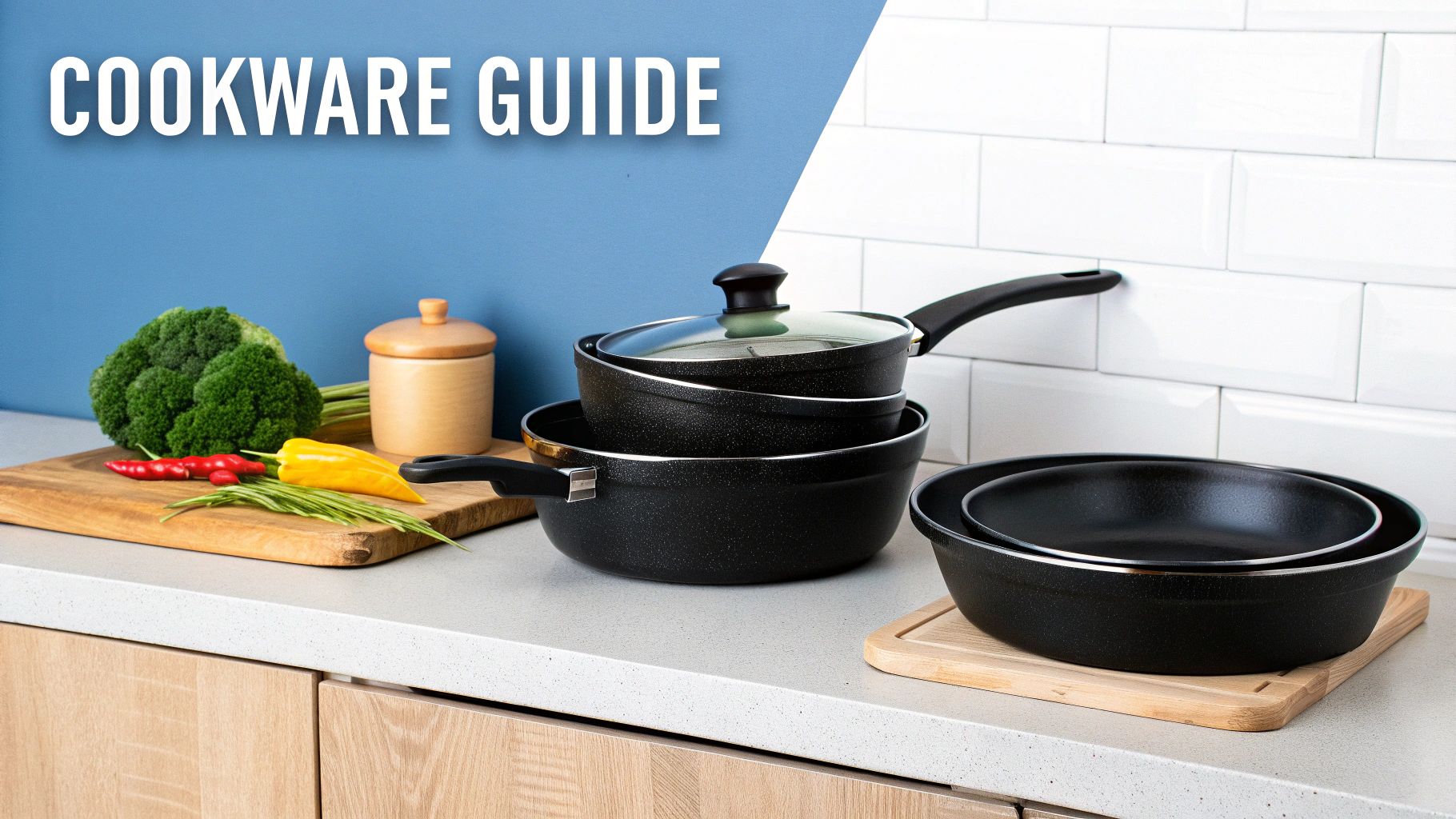
Traditional Non-Stick Pans
For decades, traditional non-stick pans, often known by the brand name Teflon, were the go-to for anyone who wanted to cook and clean up with zero fuss. Their slick surface comes from a chemical coating called Polytetrafluoroethylene (PTFE). It’s what lets you flip an egg without a spatula and a prayer.
But that convenience comes with a pretty big catch. When these pans get too hot—and we’re not talking inferno, just a bit above medium heat—the PTFE coating can start to break down and release toxic fumes. Worse, if you scratch the surface with a metal utensil, the coating can flake right off into your food.
The main worry here is a group of chemicals called PFAS (per- and polyfluoroalkyl substances), which were used to make these coatings for years. These "forever chemicals" have been linked to some serious health issues, which is why so many health-conscious home cooks are now looking for alternatives.
Ceramic Coated Cookware
As people started looking for an alternative to traditional non-stick, ceramic-coated cookware really took off. These pans usually have an aluminium base with a sand-derived ceramic layer that’s applied like a glaze. They’re often marketed as the "green" or "healthy" non-stick option because they’re free from PTFE and PFOA.
At first, ceramic coatings work beautifully. But their durability can be a real issue. The coating is more brittle than PTFE and tends to chip and scratch pretty easily. Once that surface is compromised, its non-stick magic disappears fast, and you’re back to scraping food off the bottom.
While they are generally a safer bet than PTFE pans, it’s crucial to know that not all ceramic cookware is made the same. The quality can vary wildly, and some cheaper versions might even contain heavy metals. If you're curious to learn more, we break down how to find a quality ceramic cookware set in Australia in our detailed guide.
A key takeaway is that the longevity of most coated pans is limited. The moment a non-stick surface, whether PTFE or ceramic, is scratched or starts to degrade, its safety and performance are compromised.
This means that while they might seem like a good short-term fix, you'll probably find yourself replacing them every few years. That adds up to a lot of waste and a recurring hit to your wallet. If you're serious about finding the best cookware for your health, a more permanent, stable material is a much better investment.
Stainless Steel Cookware
Stainless steel is the undisputed workhorse of the professional kitchen, loved by chefs for its brilliant heat control and sheer durability. It's an alloy made mostly from iron, with chromium and sometimes nickel added to fight off rust and corrosion. Unlike coated pans, its surface won't chip, peel, or break down over time.
This material is also wonderfully non-reactive. That means you can simmer a big pot of acidic tomato sauce or a tangy citrus glaze without worrying about a metallic taste or chemicals leaching into your dish. High-quality stainless steel, often stamped with 18/10 or 18/8, tells you the percentage of chromium and nickel, which is a good sign you’re getting a tough, non-porous surface.
The only real learning curve with stainless steel is getting the heat management right to stop food from sticking. It takes a little practice—preheating the pan properly and using the right amount of oil is key. But once you get the hang of it, a good stainless steel pan is incredibly versatile and can honestly last a lifetime.
Cast Iron Skillets
Cast iron is one of the oldest and most trusted materials in the kitchen, and for good reason. It’s famous for its incredible heat retention and will outlive just about everything else you own. A well-seasoned cast iron skillet develops a fantastic natural non-stick surface over time, created by layers of oil baked right into the pan.
This stuff is virtually indestructible; it’s the kind of cookware that gets passed down through generations. It's unbeatable for searing steaks, frying chicken, and baking, giving food a beautiful, even crust.
Cast iron isn't without its quirks, though. It’s heavy, can rust if you don’t dry it properly, and needs regular "seasoning" to keep that non-stick surface in top shape. It's also reactive with acidic foods, which can strip the seasoning and cause it to leach small, generally harmless amounts of dietary iron into your food. While this can be a plus for some, it might change the flavour of more delicate recipes.
A Quick Comparison of Your Options
To make things a bit clearer, let's lay out the pros and cons of these common materials side-by-side. Every material has its place, but when health and safety are the top priority, the differences become pretty stark.
Cookware Material Health and Safety Comparison
| Material | Potential Health Risks | Heat Performance | Durability | Best For |
|---|---|---|---|---|
| Titanium (Pure) | None. Completely inert and biocompatible. | Excellent, even heating. | Exceptional. Resists scratches, warping, and corrosion. | Everyday cooking, acidic foods, high-heat searing—everything. |
| Stainless Steel | Leaching of nickel and chromium in low-quality pans. | Very good heat distribution. | Excellent. Very resistant to scratching and dents. | Searing, sautéing, and cooking acidic sauces. |
| Cast Iron | Can leach iron into acidic foods, which can alter taste. | Superior heat retention, but slower to heat up. | Virtually indestructible but requires maintenance. | Searing, frying, baking, and dishes requiring steady heat. |
| Ceramic Coated | Low-quality coatings may contain heavy metals. | Good, but can develop hot spots as it wears. | Poor. Prone to chipping and scratching. | Low to medium-heat cooking for eggs and delicate fish. |
| Non-Stick (PTFE) | Fumes from overheating and ingestion of flaked coatings (PFAS). | Good, but high heat should be avoided. | Poor. Easily scratched and degrades with use. | Low-heat, non-stick tasks like pancakes and eggs. |
Looking at the table, it’s clear that materials without coatings, like titanium and high-quality stainless steel, offer the most peace of mind for health-conscious cooks. They eliminate the risk of chemical leaching and last significantly longer.
Titanium: A Premier Healthy Choice
And that brings us to pure titanium, a material that really stands apart as one of the best choices for health-focused cooking. Titanium is a completely inert, non-reactive, and non-toxic element. It’s the very same biocompatible material used for medical implants because the human body simply doesn't react to it.
What does this mean for your cooking? It means your pan will never leach chemicals or metals into your food, no matter how high you turn up the heat or how acidic your ingredients are. Its surface is also completely non-porous, which stops bacteria from building up and makes it incredibly hygienic.
Why Titanium Excels for Health
- Completely Inert: It won’t react with acids or alkaline foods, so it perfectly preserves the natural taste and nutritional value of your ingredients.
- Extremely Durable: Titanium is unbelievably strong yet surprisingly lightweight. It resists scratches, corrosion, and warping far better than any other material.
- Non-Porous Surface: This clever feature prevents the pan from absorbing flavours, odours, and microbes, ensuring it’s truly clean after every single wash.
While pure titanium cookware is a bigger initial investment, its incredible lifespan and unmatched safety profile make it a very smart choice. You're not just buying another pan; you’re investing in a permanent tool for a healthy kitchen that will never need replacing because of a worn-out surface. For anyone serious about finding the best cookware for their health, it's a superior option in every way.
The Hidden Dangers of "Forever Chemicals" in Pans
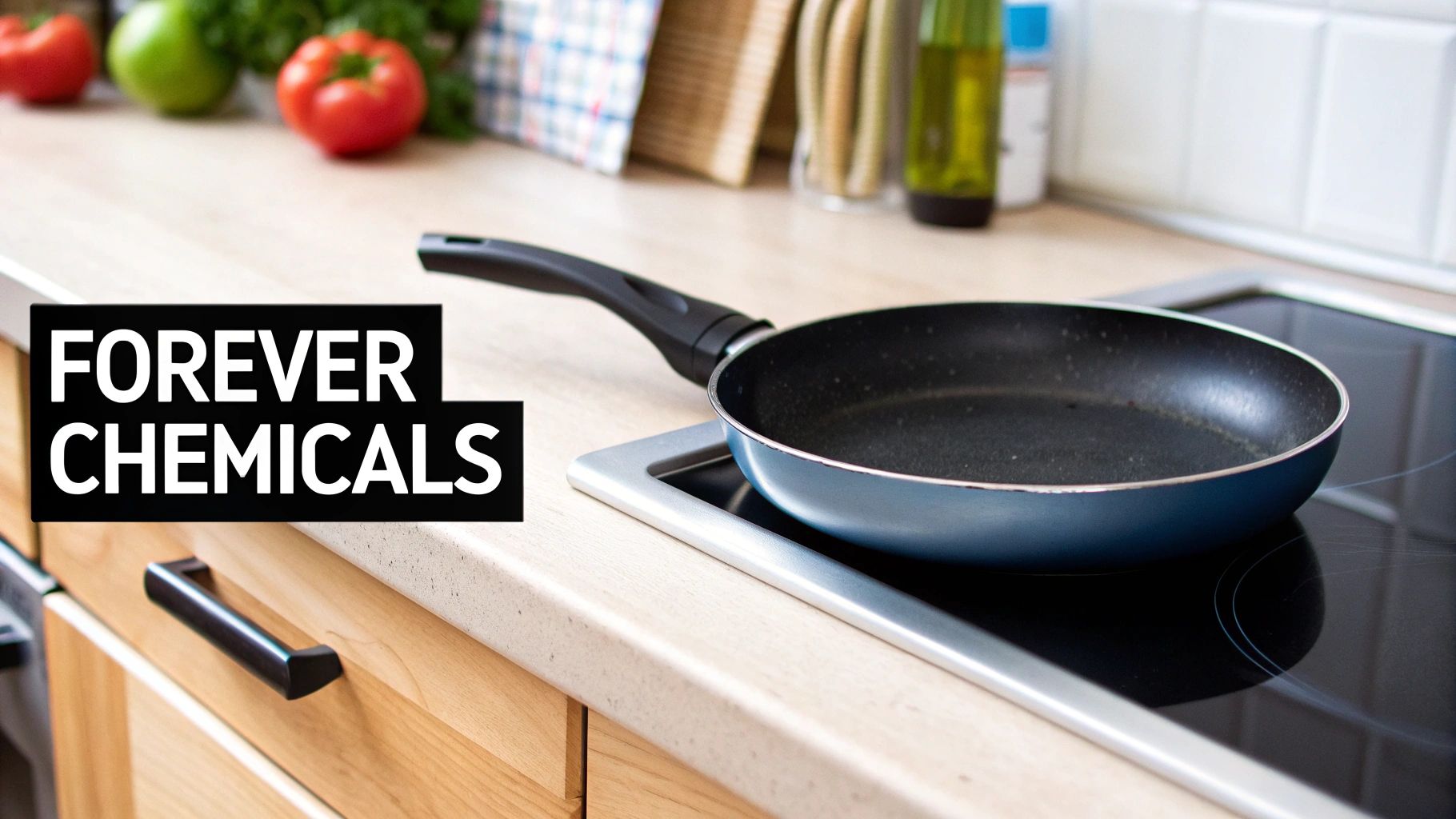
For decades, the perfect, no-mess fried egg was a kitchen marvel. It seemed like magic, but the science behind it was all too real, built on a group of synthetic compounds known as PFAS (per- and polyfluoroalkyl substances).
You’ve probably heard of them as "forever chemicals"—and for good reason. They were the secret ingredient in traditional non-stick technology. Their unique structure made them incredibly resistant to heat, water, and oil, creating that flawless, slick surface we all came to rely on.
But that same resilience is exactly what makes them a problem. Once these chemicals get into the environment or our bodies, they don't break down. They just hang around, accumulating in our tissues and organs, which has set off major alarms for health experts across the globe.
Unpacking the Health Risks of PFAS
The trouble with PFAS-based non-stick coatings really starts when the pan gets too hot or the surface gets scratched. High heat can cause the coating to degrade, releasing fumes that might lead to flu-like symptoms. What's even more worrying, though, is what happens when you accidentally scrape it with a metal spatula.
When the surface is damaged, tiny, invisible particles of the coating can flake off directly into your food. A little bit here and there might not seem like a big deal, but think about the cumulative effect over years of daily cooking. That’s where the real risk lies.
A growing mountain of scientific research has linked long-term exposure to PFAS with a disturbing list of health problems. We're not talking minor issues, but serious conditions that can affect your long-term wellbeing.
- Hormonal Disruption: PFAS can mess with the body's endocrine system, which is in charge of regulating critical hormones.
- Liver Damage: Our livers work hard to filter out toxins, and a buildup of these chemicals can cause serious harm.
- Increased Cancer Risk: Certain types of PFAS have been linked to a higher risk of developing kidney and testicular cancers.
- Immune System Issues: Exposure can weaken the immune system, making it harder to fight off infections.
It's become crystal clear that the convenience of some older non-stick pans comes at a steep price. A simple kitchen tool can become a source of long-term chemical exposure. To explore the alternatives, our guide on non-stick frying pans with lids offers more detail on making safer choices.
Australia's Decisive Action on Forever Chemicals
Thankfully, governments are starting to catch on. Australia has taken a firm stand to protect both public health and the environment by banning some of the most harmful PFAS chemicals that have been commonly used in cookware.
These particular forever chemicals—including PFOS, PFOA, and PFHxS—are notorious for their persistence and potential health impacts. From 1 July 2025, Australia will officially prohibit the manufacture, import, and use of these substances under strict new regulations.
This ban is a massive step forward. It officially validates the concerns health-conscious Aussies have had for years and signals a huge shift in what we consider safe for our kitchens. You can read more about how this initiative is reshaping cookware standards in Australia on solidteknics.com.
This isn’t just some distant government policy; it’s a powerful tool for you as a consumer. It confirms that choosing the best cookware for health means actively steering clear of these soon-to-be-banned substances. It connects the dots between national safety standards and the pan you use to cook breakfast, empowering you to make a choice that aligns with a healthier, safer future for your family.
Why Titanium Is a Superior Choice for Healthy Cooking
After wading through the minefield of cookware materials—from the 'forever chemicals' in old-school non-stick pans to the chipping and flaking of some ceramic coatings—it's easy to feel a bit lost. So, what's the real answer for a truly health-conscious kitchen? More and more, the evidence points to one remarkable material: pure titanium. It’s not just a good option; it’s the gold standard for anyone who refuses to compromise on safety.
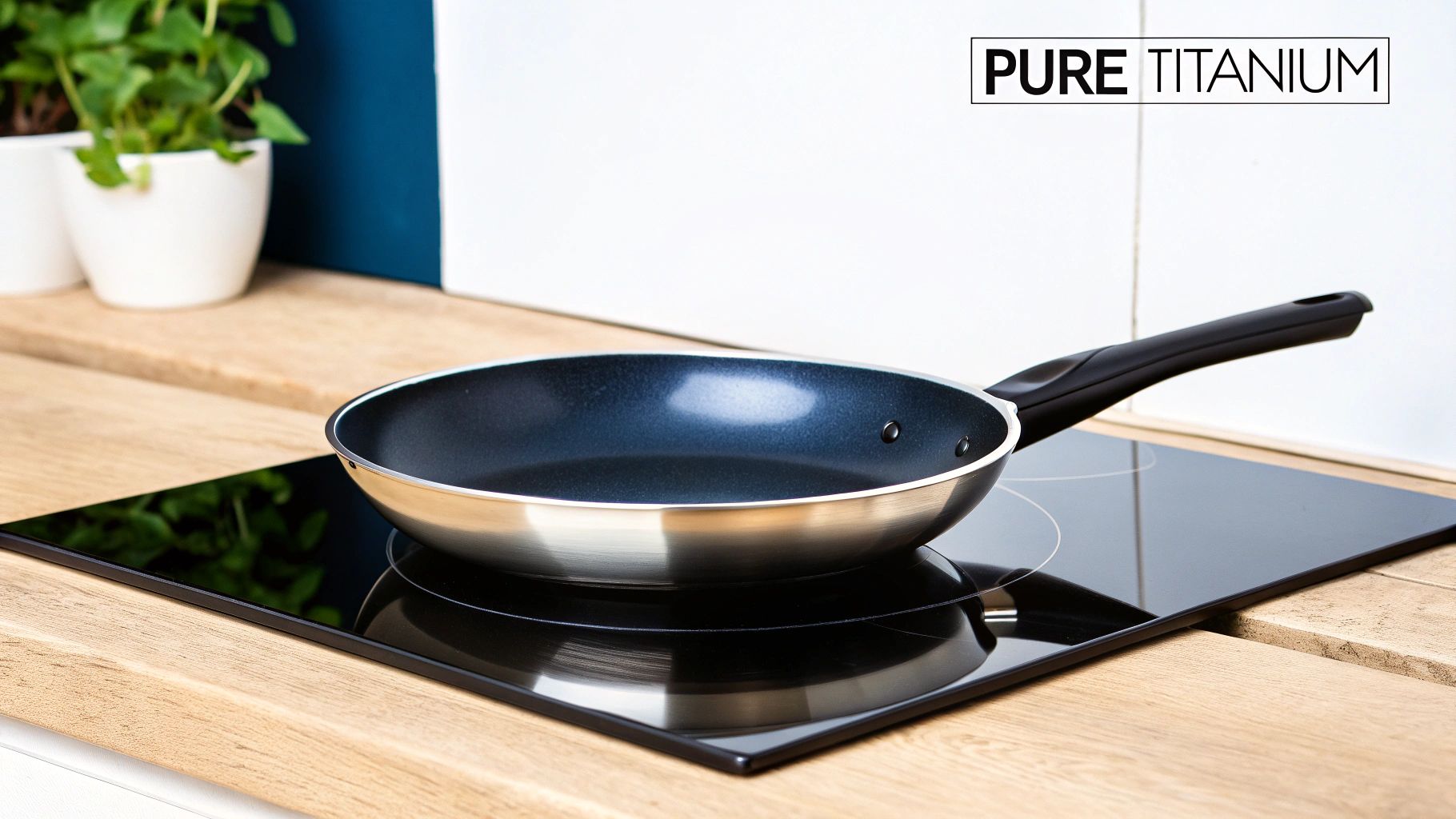
Think of titanium as the ultimate neutral party in your kitchen. There’s a reason it’s the material of choice for surgical implants and joint replacements—our bodies simply don’t react to it. This exact quality, known as biocompatibility, is what makes it one of the best cookware for health you can buy.
Because it’s so chemically inert, you can be sure your pan will never interfere with your food. Go ahead and simmer a rich, acidic tomato sauce for hours or deglaze with a splash of wine. You’ll never have to worry about a metallic tang or unwanted chemicals leaching into your meal. The flavour you get is the one you created, pure and simple.
The Science of a Truly Non-Porous Surface
One of the most incredible features of pure titanium is its completely non-porous surface. Picture the difference between a smooth sheet of glass and a natural sea sponge. Materials like cast iron have a slightly porous texture that famously soaks up oils to create that beloved seasoning. Titanium, on the other hand, is flawlessly sealed.
This seemingly small detail delivers two massive health benefits:
- Ultimate Hygiene: A non-porous surface leaves no microscopic nooks or crannies for bacteria or old food particles to hide. When you wash your titanium pan, it gets truly clean, preventing any chance of cross-contamination.
- Purity Preservation: Since nothing gets absorbed, the pan won't hang onto the ghost of last night's garlic stir-fry when you’re making delicate crepes the next morning. It gives you a perfectly fresh start, every single time.
This level of hygiene is something many other materials just can't match, making high-purity titanium an excellent choice for families dealing with allergies or anyone prioritising a spotless cooking environment.
With titanium, you get a pristine cooking surface every single time. It's the assurance that your cookware isn’t just clean to the eye but is hygienically clean at a microscopic level, safeguarding the health and flavour of your meals.
Built to Last a Lifetime and Beyond
When you're investing in healthy cookware, you need it to last. Durability isn't just about getting value for money; it's a safety issue. A pan that scratches, warps, or corrodes can quickly become a health hazard if its surface integrity is compromised. This is where titanium really pulls away from the pack.
Titanium has an incredible strength-to-weight ratio, which makes it remarkably tough yet surprisingly light to handle. It naturally resists scratches, even from metal utensils, stands up to extreme heat without buckling, and will never rust or corrode. One good titanium pan can easily outlive a whole stack of coated pans you'd otherwise have to throw away. For a balanced look, you can explore the full pros and cons of using titanium cookware in our detailed guide.
Choosing titanium is a long-term investment in your kitchen and your well-being. By opting for cookware made from SGS-verified 99.9% pure titanium, like the pieces we offer at Everti, you’re getting a product certified to be free from nasty impurities and built to perform for generations. It’s a smart, sustainable decision that rejects the disposable mindset in favour of enduring quality, ensuring your kitchen is equipped with the safest tools for years to come.
How to Find Genuinely Non-Toxic Cookware
Trying to navigate the world of cookware can feel like a total guessing game. Brands are constantly throwing around buzzwords like "green," "eco-friendly," and "healthy," making it tough to figure out what’s genuine and what’s just clever marketing. If you want to find the best cookware for your health, the secret is to look past the slogans and focus on the proof.
To cut through all that noise, you need a reliable way to check what a brand is actually telling you. This is where independent, third-party certifications become your best friend—think of them as a trustworthy referee in the cookware game.
The Power of Third-Party Verification
A reputable certification isn't just a fancy logo slapped on a box. It represents a serious, unbiased deep-dive into a product's safety and what it's really made of. When a brand sends its cookware off for testing, they're basically inviting an outside expert to hold them to account.
This whole process involves scientific analysis, checking for nasty stuff like heavy metals, BPA, and those "forever chemicals" you hear about, like PFAS. Certifications from globally recognised bodies like SGS give you a guarantee that the material is exactly what the brand claims it is.
A third-party certification is the difference between a brand saying their cookware is safe and a brand proving it. It’s your assurance that the product has been scientifically tested and verified to meet strict health and safety standards.
At Everti, for example, we make sure our products are made from SGS-verified 99.9% pure titanium because, for us, transparency is non-negotiable. This verification is your proof that our cookware is free from harmful impurities, so you can cook with complete peace of mind.
Your Checklist for Choosing Safe Cookware
When you're ready to invest in genuinely non-toxic cookware, don't just fall for the marketing slogans. Use this simple checklist to guide you and make sure you’re bringing home something that truly supports your health goals.
-
Seek Out Certifications: Look for proof of third-party testing from respected organisations. Any brand that’s truly proud of their material quality will make these results easy for you to find.
-
Demand Material Transparency: A trustworthy brand will be completely upfront about what their cookware is made of. Steer clear of vague descriptions and look for specific details, like "18/10 stainless steel" or "pure, unalloyed titanium."
-
Investigate the Brand’s Reputation: Do they talk about health and safety as a priority? Look for educational content and a clear commitment to non-toxic principles, not just flashy sales pitches.
This shift towards verified safety is a big deal right now. Expert assessments in Australia have raised some serious red flags about traditional non-stick pans containing PFAS. Because of this, many Australian home cooks are now actively looking for safer materials like cast iron, stainless steel, and other verified non-toxic options. Brands that can show they’ve had their products independently tested for toxins are the ones earning real trust. You can find out more about cookware safety in Australia on sbs.com.au.
By following this checklist, you can see right through the marketing hype and pick out cookware that is genuinely safe. It puts the power back in your hands, allowing you to make a confident choice and know your kitchen is a place that protects your family’s well-being.
Got Questions About Healthy Cookware? We’ve Got Answers.
Stepping into the world of healthy cookware often brings up more questions than answers. Even once you’ve settled on a material, the day-to-day practicalities of using, cleaning, and caring for it can feel a little daunting. This section is designed to clear up that confusion with simple, direct answers to your most common questions.
Think of this as your go-to guide for sorting out any lingering doubts. We’ll cover everything from getting the perfect sear to choosing the right cooking oil, so you can step into your kitchen with total confidence.
What’s the Best Oil to Use?
The right oil really comes down to what you’re cooking and how hot you’re cooking it. For high-heat searing in pans made from titanium or stainless steel, you absolutely need an oil with a high smoke point. That’s the temperature where the oil starts to burn and break down, creating nasty free radicals you don’t want anywhere near your food.
For high-temperature cooking, these are your best bets:
- Avocado oil: With a smoke point around 270°C, it’s one of the most stable oils you can find.
- Ghee (clarified butter): Fantastic for searing and frying, ghee has a smoke point of about 250°C.
- Light olive oil: Don't confuse this with extra virgin! Light olive oil is more refined and has a higher smoke point of around 240°C.
When you’re sautéing at lower temperatures or baking, you’ve got more options. Extra virgin olive oil and coconut oil are wonderful for adding flavour and offer great health benefits, but they’re best kept over a medium heat to stop them from burning.
How Do I Stop Food from Sticking to My Pans?
Making the switch from coated non-stick pans to materials like stainless steel or titanium can feel like a bit of a learning curve, but stopping food from sticking is actually pretty simple once you get the hang of two things: proper preheating and using the right amount of fat.
First, always preheat your pan. Pop it on the stove over a medium heat for a minute or two before you add a single thing. A great little trick is the water test: flick a few drops of water into the pan. If they sizzle and bead up, dancing across the surface, you’re good to go.
Next, add your oil or butter and let it get hot enough to shimmer. This creates a temporary non-stick barrier between the hot metal and your food. Almost every time food sticks, it’s because this step was rushed.
Think of preheating as creating a temporary shield. The hot pan and shimmering oil form a barrier that stops food proteins from bonding directly with the metal, allowing your ingredients to slide freely instead of sticking fast.
Is It Okay to Use Metal Utensils?
This one depends entirely on your cookware’s material. If you’re using traditional non-stick or ceramic-coated pans, using metal utensils is a huge no-no. You’ll scratch the delicate surface in a heartbeat, causing it to wear away and potentially flake into your meal.
But for more robust materials, it’s a completely different story:
- Pure Titanium: This stuff is incredibly scratch-resistant. High-quality titanium pans can handle metal utensils without breaking a sweat.
- Stainless Steel: Generally very tough and can easily stand up to metal spatulas and whisks.
- Cast Iron: It’s practically indestructible. Go ahead and use those metal utensils.
Bottom line: for any coated cookware, stick to wood, bamboo, or food-grade silicone utensils to protect the surface and make it last.
How Often Should I Replace My Cookware?
How long your cookware lasts comes down to what it’s made of and how well you look after it. For coated pans, the rule is simple: the moment you see any scratches, chips, or signs of wear, it’s time for a replacement. Once that protective layer is compromised, it's neither safe nor effective.
For uncoated, hard-wearing materials, however, the future is much brighter. A well-maintained set of pure titanium, stainless steel, or cast iron cookware can genuinely last a lifetime—some even become family heirlooms. These materials don't have a coating that can fail, which makes them a far more sustainable and budget-friendly choice in the long run. Invest in quality from the start, and you might never have to buy another pan again.
Ready to invest in cookware that is built for a lifetime of healthy cooking? The Everti collection of SGS-verified 99.9% pure titanium cookware offers unparalleled safety, durability, and performance. Explore our range and elevate your kitchen at https://everti.com.au.

